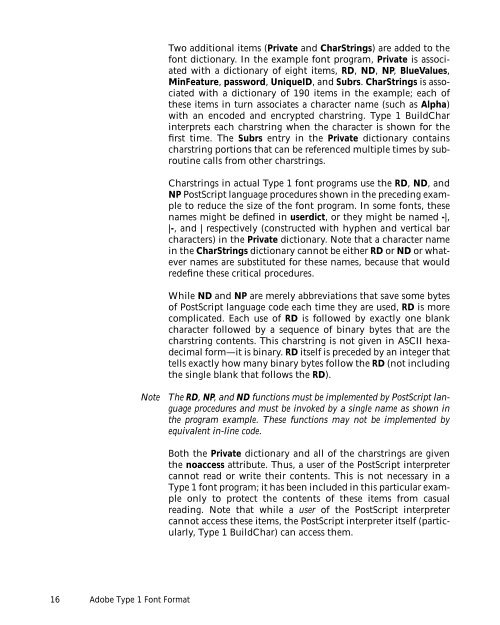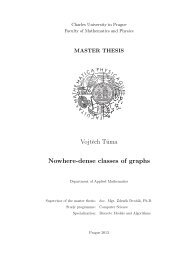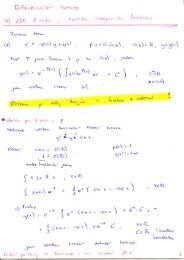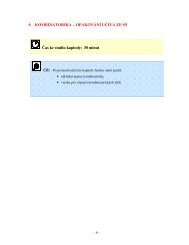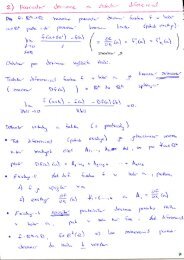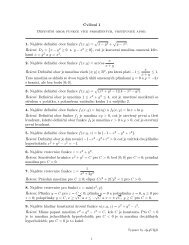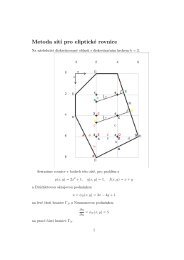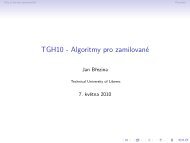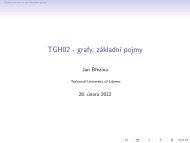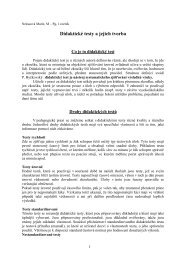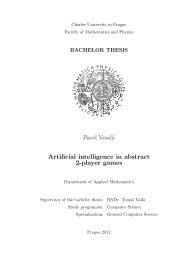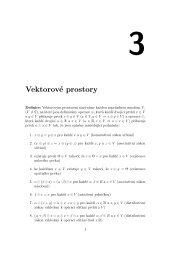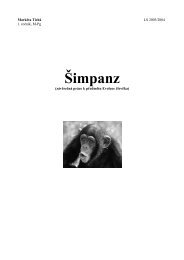The Adobe Type 1 Font Format book (PDF: 445 KB) - Adobe Partners
The Adobe Type 1 Font Format book (PDF: 445 KB) - Adobe Partners
The Adobe Type 1 Font Format book (PDF: 445 KB) - Adobe Partners
Create successful ePaper yourself
Turn your PDF publications into a flip-book with our unique Google optimized e-Paper software.
16 <strong>Adobe</strong> <strong>Type</strong> 1 <strong>Font</strong> <strong>Format</strong><br />
Two additional items (Private and CharStrings) are added to the<br />
font dictionary. In the example font program, Private is associated<br />
with a dictionary of eight items, RD, ND, NP, BlueValues,<br />
MinFeature, password, UniqueID, and Subrs. CharStrings is associated<br />
with a dictionary of 190 items in the example; each of<br />
these items in turn associates a character name (such as Alpha)<br />
with an encoded and encrypted charstring. <strong>Type</strong> 1 BuildChar<br />
interprets each charstring when the character is shown for the<br />
first time. <strong>The</strong> Subrs entry in the Private dictionary contains<br />
charstring portions that can be referenced multiple times by subroutine<br />
calls from other charstrings.<br />
Charstrings in actual <strong>Type</strong> 1 font programs use the RD, ND, and<br />
NP PostScript language procedures shown in the preceding example<br />
to reduce the size of the font program. In some fonts, these<br />
names might be defined in userdict, or they might be named -|,<br />
|-, and | respectively (constructed with hyphen and vertical bar<br />
characters) in the Private dictionary. Note that a character name<br />
in the CharStrings dictionary cannot be either RD or ND or whatever<br />
names are substituted for these names, because that would<br />
redefine these critical procedures.<br />
While ND and NP are merely abbreviations that save some bytes<br />
of PostScript language code each time they are used, RD is more<br />
complicated. Each use of RD is followed by exactly one blank<br />
character followed by a sequence of binary bytes that are the<br />
charstring contents. This charstring is not given in ASCII hexadecimal<br />
form—it is binary. RD itself is preceded by an integer that<br />
tells exactly how many binary bytes follow the RD (not including<br />
the single blank that follows the RD).<br />
Note <strong>The</strong> RD, NP, and ND functions must be implemented by PostScript language<br />
procedures and must be invoked by a single name as shown in<br />
the program example. <strong>The</strong>se functions may not be implemented by<br />
equivalent in-line code.<br />
Both the Private dictionary and all of the charstrings are given<br />
the noaccess attribute. Thus, a user of the PostScript interpreter<br />
cannot read or write their contents. This is not necessary in a<br />
<strong>Type</strong> 1 font program; it has been included in this particular example<br />
only to protect the contents of these items from casual<br />
reading. Note that while a user of the PostScript interpreter<br />
cannot access these items, the PostScript interpreter itself (particularly,<br />
<strong>Type</strong> 1 BuildChar) can access them.


